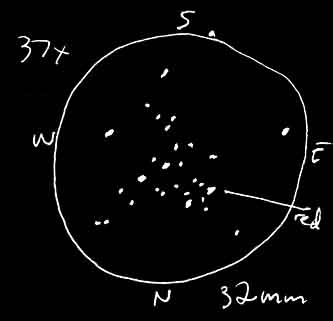
Observation Notes:
This open cluster is NW of M7 in Scorpius. I noticed more graininess in the background compared to M7. It was also tighter than M7 and filled about 20' of the 1.4° view. The pattern that stood out to me right away was a parallelagram of 4 bright stars on the NE side of the cluster. The star on the E corner of the parallelagram appeared red. I didn't realize this was called the Butterfly Cluster until later, and that shape wasn't immediately apparent to me. The next time I check it out, I'll be looking for that shape.
Factoids:
While the main portion of this open cluster spans 25', the approximately 80 identified stars actually span a region 54' across. M6 is estimated to be about 1600 light years distant with a diameter of 25 light years for the entire cluster (12 light years for the main concentration). Its age has been estimated anywhere from 51 million to 100 million years. The star I noticed to be red is identified as a yellow or orange supergiant variable star. It's variability ranges from magnitude 5.5 to 7 and this directly affects to the overall brightness of the whole cluster.
| Subject | M6/NGC 6405 |
| Classification | Open Cluster |
| Position | Scorpius [RA: 17:40.1 / Dec: -32:13]* |
| Size* | 25' |
| Brightness* | 4.2 |
| Date/Time | 10/3/04 - 8:15 PM |
| Observing Loc. | Flagstaff, AZ - Home |
| Instrument | Orion SVP 6LT Reflector (150 mm dia./1200 mm F/L) |
| Eyepieces/Mag. | 32 mm (37X) |
| Seeing | 5/10 |
| Transparency | Mag 4.5 |
* Based on published data.




